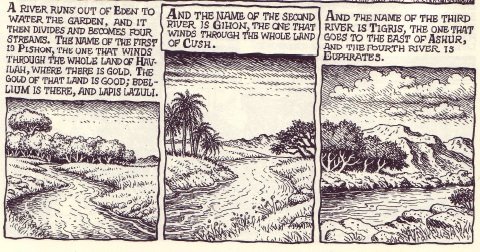

"... Lake Van is one of the world's largest endorheic lakes (having no outlet). The original outlet from the basin was blocked by an ancient volcanic eruption. ... The lake's outlet was blocked at some time during the Pleistocene, when lava flows from Nemrut volcano blocked westward outflow ... Nemrut Dagi is close to the western shore of the lake,
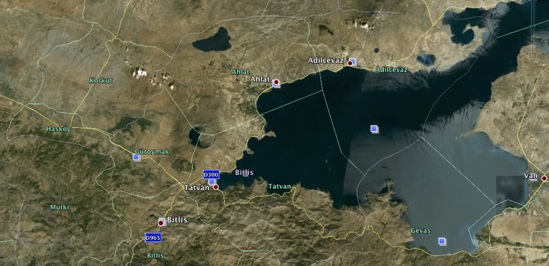
and another dormant stratovolcano, Suphan Dagi dominates the northern side of the lake. ...
the highest lake levels (72 metres (240 ft) above the current height) had been during the last ice age, about 18,000 years ago.
About 9,500 years ago there was a dramatic drop to more than 300 metres (980 ft) below the present level.
This was followed by an equally dramatic rise around 6,500 years ago. ...". (text from Wikipedia on Lake Van, image from google earth)
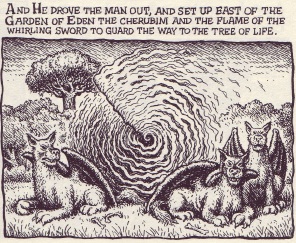
The mitochondrial mtDNA Markers of this map (from the National Geographic Genographic program)
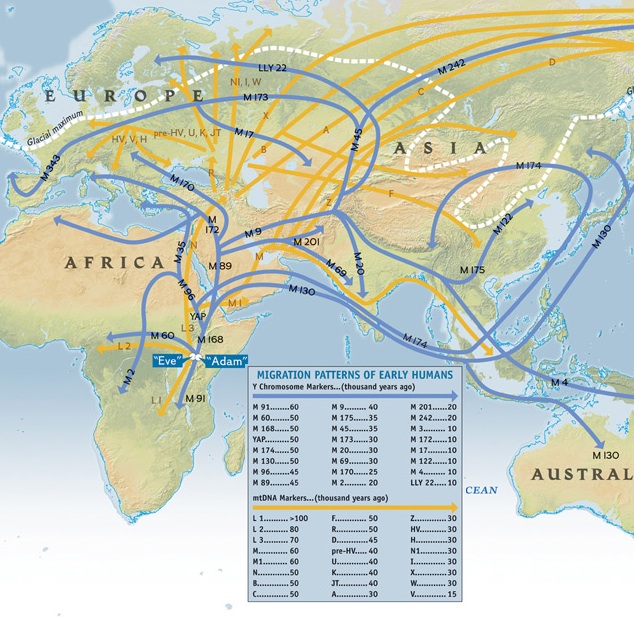
show that migration out of the Urartian Eden of Genesis near Lake Van took place around 50 kyr to 30 kyr ago, somewhat before the highest lake levels of Lake Van (about 18 kyr ago), and so possibly related to volcanic activity of Nemrut Dagi.
From this point of view, the Eden of Genesis would have been a later center of civilization than the original Human Origin site of Mitochondrial Eve, which would have been in the African Nile Valley over 100 kyr ago.
According to Genographic materials: ".. modern Homo sapiens evolved 200,000 years ago in the highlands of East Africa. Geneticists agree, tracing the mitochondrial DNA of everyone alive today back to the ancestral female who lived in the region roughly 150,000 years ago. ... an early ... mtDNA ... lineage ... L3 ... stem[s] from the "Eve" rootstock, probably appearing in northeast Africa around 70,000 years ago ... it branched ...
M ... points toward Australia but gave rise along the way to lineages ( C, D, Z ) ... found in Central Asia and Siberia ...N ... reflect[s] movement up through the Middle East into Eurasia, where subsequent lineages ( X, A, B, and R among them ) branch north toward the Arctic [ A, X, a branch of B ], west toward Europe [ R ], and east toward central China [ F and a branch of B ] ...
"Eve" is mirrored by an "Adam" who dwelt on those same savannas about 60,000 years ago ...
Early mutations ( M91, M60 ) on the Y chromosome rootstock bequeathed by "Adam" are found in modern African males ...
Soon thereafter, another mutation( M168 ) arose in ... northeast Africa - and the lineages he fathered colonized the rest of the world ...
YAP ... reflect[ed] subsequent movements in Africa [ M96, M2 ] , the Mediterranean [ M96, M35 ], and East Asia [ M174 ], but its incidence is rare today in most non-African populations ...M130, [f]ound principally in Southeast Asian and Australian Aboriginal males ... reflects what may be the earliest substantial migration out of Africa, occurring more than 50,000 years ago. Sea levels were lower then, and these beachcombing humans probably followed the long sandy coasts of Arabia, India, and Southeast Asia ...
M89 ... indicates a migration that left northeast Africa and enetered the Middle East about 45,000 years ago. Crossing the margins of Arabia, M89 gave rise to further lineages,
including M9, which marks a turn east toward the game-rich Eurasian grasslands. ... When they encountered the great mountain ranges of the Hindu Kush, the Pamirs, and the Tien Shan, these tribes then dispersed in different directions, each ... traced by its own genetic marker ...M175 ... skirted the mountains and desert to arrive in China ...M20 ... crossed the high passes into India ...
M45 ... turned to the north toward the broad rolling steppes of Central Asia ...[and]... eventually gave rise to most of the peoples of Western Europe, Siberia, and the Americas ...
The true European ancestors were the tall, lithe new-comers bearing the genetic marker M173 on their Y choromosomes, who arrived after generations spent on the Central Asian steppes ...".
...
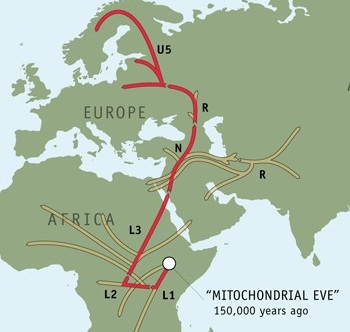
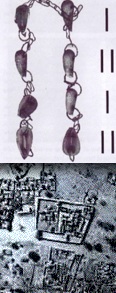
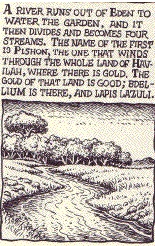
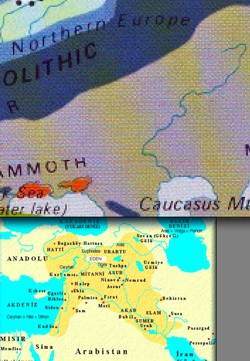
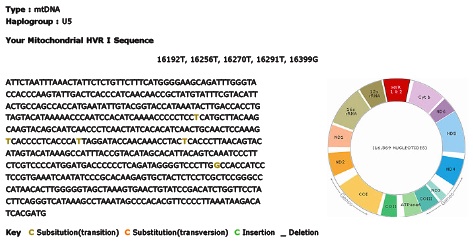
... Homo sapiens evolved in Africa around 200,000 years ago, and the first hominids characterized by their unique bipedal stature appeared nearly two million years before that. ... about 150,000 to 170,000 years ago, a woman was born from whom we are all descended. ... Eventually, for any number of reasons, all of the other lineages of people went extinct, and "Mitochondrial Eve" as we call her, was the only female who had descendants that are now living in the present day. ...
The L Haplogroups: The Deepest Branches ... L1 ... likely originated in East Africa and then spread throughout the rest of the continent. ...
Haplogroup L2: West Africa ... L2 individuals are most predominant in West Africa ...
Haplogroup L3: Out of Africa ... around 80,000 years ago began haplogroup L3. ... L3 is important for its movements north. ... they are the first modern humans to have left Africa, representing the deepest branches of the tree found outside of that continent. ... Around 50,000 years ago the ice sheets of northern Europe began to melt, introducing a period of warmer temperatures and moister climate in Africa. Parts of the inhospitable Sahara briefly became habitable. ... Your nomadic ancestors followed the good weather and plentiful game northward ...
Haplogroup N: The Incubation Period [ in Eden ] ... The second great wave, also of L3 individuals, moved north rather than east and left the African continent across the Sinai Peninsula ...
Haplogroup R: Spreading Out [ along the Pishon = Aras + Volga ] ... Some moved south [ along the Gihon = Ceyhan + Nile ], migrating back into northern Africa. Others went west [ along the Tigris and Euphrates ] across Anatolia (present-day Turkey) and north [ along the Pishon = Aras + Volga ] across the Caucasus Mountains of Georgia and southern Russia ...
Haplogroup U5: [ Finland ] ... the most recent common ancestor for all U5 individuals ... broke off from the rest of the group and headed north into Scandinavia. ... U5 is ... estimated to be around 50,000 years old. U5 is quite restricted in its variation to Scandinavia, and particularly to Finland. ...".
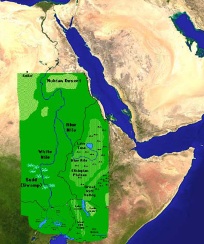
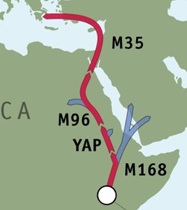
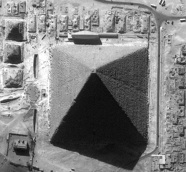
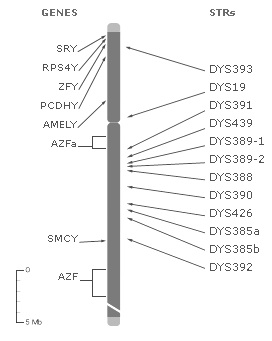
... Type Y-Chromosome Haplogroup E3b1(M35)
Your STRs
... Above are results from the laboratory analysis of your Y-chromosome. Your DNA was analyzed for Short Tandem Repeats (STRs), which are repeating segments of your genome that have a high mutation rate. The location on the Y chromosome of each of these markers is depicted in the image, with the number of repeats for each of your STRs presented to the right of the marker. For example, DYS19 is a repeat of TAGA, so if your DNA repeated that sequence 12 times at that location, it would appear: DYS19 12. Studying the combination of these STR lengths in your Y Chromosome allows researchers to place you in a haplogroup, which reveals the complex migratory journeys of your ancestors. ...
Your Y-chromosome results identify you as a member of haplogroup E3b1.
The genetic markers that define your ancestral history reach back roughly 60,000 years to the first common marker of all non-African men, M168, and follow your lineage to present day, ending with M35, the defining marker of haplogroup E3b1. Some in this lineage also carry the markers M215 (E3b), M35 (E3b1), M78 (E3b1a), M81 (E3b1b), M183 (E3b1b2), M123 (E3b1c), and M34 (E3b1c1).
If you look at the map highlighting your ancestors' route, you will see that members of haplogroup E3b1 carry the following Y-chromosome markers:
M168 > YAP > M96 > M35
Today, the E3b1 line of descent is most heavily represented in Mediterranean populations. Approximately 10 percent of the men in Spain belong to this haplogroup, as do 12 percent of the men in northern Italy, and 13 percent of the men in central and southern Italy. Roughly 20 percent of the men in Sicily belong to this group. In the Balkans and Greece, between 20 to 30 percent of the men belong to E3b1, as do nearly 75 percent of the men in North Africa. The haplogroup is rarely found in India or East Asia. Around 10 percent of all European men trace their descent to this line. For example, in Ireland, 3 to 4 percent of the men belong; in England, 4 to 5 percent; Hungary, 7 percent; and Poland, 8 to 9 percent. Nearly 25 percent of Jewish men belong to this haplogroup. ...
M168: Your Earliest Ancestor ... arose ... in northeast Africa ... and the lineages he fathered colonized the rest of the world ..
Skeletal and archaeological evidence suggest that anatomically modern humans evolved in Africa around 200,000 years ago, and began moving out of Africa to colonize the rest of the world around 60,000 years ago. The man who gave rise to the first genetic marker in your lineage probably lived in northeast Africa in the region of the Rift Valley, perhaps in present-day Ethiopia, Kenya, or Tanzania, some 31,000 to 79,000 years ago. Scientists put the most likely date for when he lived at around 50,000 years ago. His descendants became the only lineage to survive outside of Africa ... It is likely that a fluctuation in climate may have provided the impetus for your ancestors' exodus out of Africa. The African ice age was characterized by drought rather than by cold. It was around 50,000 years ago that the ice sheets of northern Europe began to melt, introducing a period of warmer temperatures and moister climate in Africa. Parts of the inhospitable Sahara briefly became habitable. As the drought-ridden desert changed to a savanna, the animals hunted by your ancestors expanded their range and began moving through the newly emerging green corridor of grasslands. Your nomadic ancestors followed the good weather and the animals they hunted, although the exact route they followed remains to be determined. ... around this same time there was a great leap forward in modern humans' intellectual capacity. ...
YAP: An Ancient Mutation ... gave rise to further markers ( M96, M174 ) apparently reflecting subsequent movements in Africa, the Mediterranean , and East Asia, but its incidence is rare today in most non-African populations ...
Sub-Saharan populations living today are characterized by one of three distinct Y-chromosome branches on the human tree. Your paternal lineage E3a falls under one of these ancient branches and is referred to by geneticists as YAP. YAP occurred around northeast Africa and is the most common of the three ancient genetic branches found in sub-Saharan Africa. It is characterized by a mutational event known as an Alu insertion, a 300-nucleotide fragment of DNA which, on rare occasion, gets inserted into different parts of the human genome during cell replication. A man living around 50,000 years ago, your distant ancestor, acquired this fragment on his Y-chromosome and passed it on to his descendants. Over time this lineage split into two distinct groups.
One is found primarily in Africa and the Mediterranean, is defined by marker M96 and is called haplogroup E.
The other group, haplogroup D, is found in Asia and defined by the M174 mutation. ...
M96: Moving Out of Africa ...[to]... the Mediterranean ...
The next man in your ancestral lineage was born around 30,000 to 40,000 years ago in northeast Africa and gave rise to marker M96 ... an ancient African lineage that chose to move north ... Beginning about 40,000 years ago, the climate shifted once again and became colder and more arid. Drought hit Africa and the grasslands reverted to desert; for the next 20,000 years, the Saharan Gateway was effectively closed. ...
M35: Neolithic Farmers ...
The final common ancestor in your haplogroup, the man who gave rise to marker M35, was born around 20,000 years ago in the Middle East. His descendants were among the first farmers and helped spread agriculture from the Middle East into the Mediterranean region. At the end of the last ice age around 10,000 years ago, the climate changed once again and became more conducive to plant production. This probably helped spur the Neolithic Revolution, the point at which the human way of living changed from nomadic hunter-gatherers to settled agriculturists. The early farming successes in the Fertile Crescent of the Middle East beginning around 8,000 years ago spawned population booms and encouraged migration throughout much of the Mediterranean world. Control over their food supply marks a major turning point for the human species. Rather than small clans of 30 to 50 people who were highly mobile and informally organized, agriculture brought the first trappings of civilization. Occupying a single territory required more complex social organization, moving from the kinship ties of a small tribe to the more elaborate relations of a larger community. It spurred trade, writing, calendars, and pioneered the rise of modern sedentary communities and cities. These ancient farmers, your ancestors, helped bring the Neolithic Revolution into the Mediterranean. ...".
As to more modern times, a 2007 article by Steven C. Bird at www.jogg.info/32/bird.htm says in part: "... The invasion of Britain by the Roman military in CE 43, and the subsequent occupation of Britain for nearly four centuries, brought thousands of soldiers from the Balkan peninsula to Britain as part of auxiliary units and as regular legionnaires. ... E3b1a2 is found to be at its highest frequency worldwide in the geographic region corresponding closely to the ancient Roman province of Moesia Superior, a region that today encompasses Kosovo, southern Serbia, northern Macedonia and extreme northwestern Bulgaria. ... The presence of Haplogroup E3b1a-M78 among the male populations of present-day Wales, England and Scotland, and its nearly complete absence among the modern male population of Ireland, provide a potential genetic indicator of settlement during the 1st through 4th Centuries CE by Roman soldiers from the Balkan peninsula and their male Romano-British descendants. ...".
My cousin Fred Smith, who shares my paternal Y-DNA, said "... the YHRD database that plots the frequency of Y-DNA results per population and geographically (actually maps it) ...[gives]... more specifics re our Y-DNA - as far as Italy is concerned, concentrated in north eastern Italy. As per our previous research, found along the Rhine near Cologne and Bonn, also the Roman settlements of Chester, London and the boundary between Wales and England, very much tracing the path that Caligula's and Claudius' armies took enroute to Britain and where stationed there. What was fascinating though is it's very high frequency in modern day Czech Republic, specifically in the region known as Vysocina, the center of which is the town of Telc ...".
It is interesting that our Y-DNA Roman Legion ancestors left descendants in Telc, but when you look at geography it makes sense. Consider the Ravenna Cosmography map made by monks in Ravenna about 700 AD
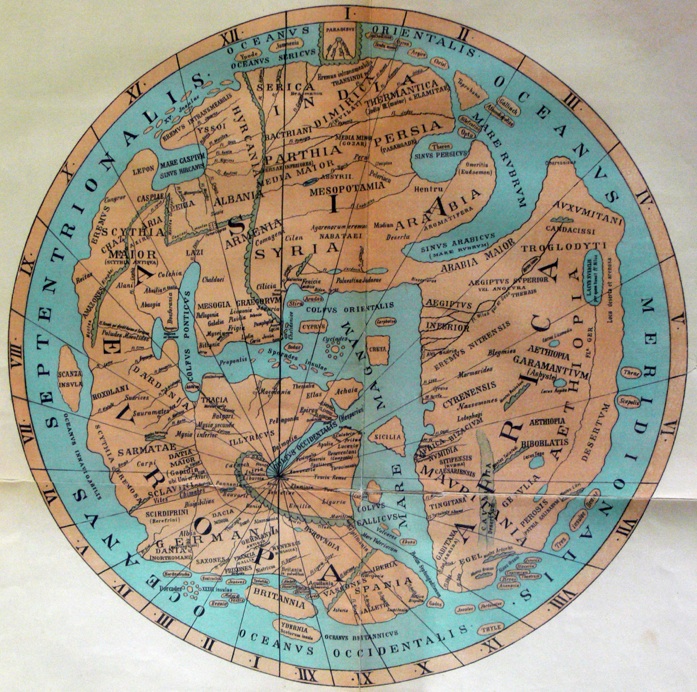
If our ancestors' Roman Legions were formed in North Eastern Italy then it would be an easier march to go around the Alps as shown on the following Google Earth images and that route would go pretty much directly to Telc
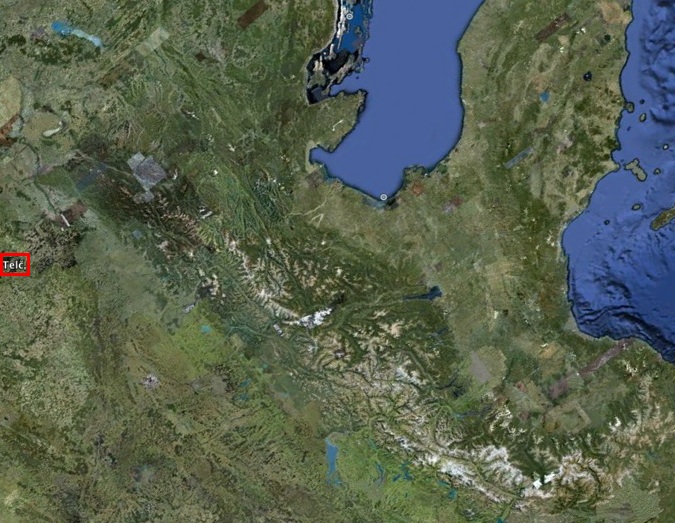
The route to Britain would then probably be directly from Telc through Germany via Sudetenland and Holland/Belgium/NorthernFrance to Britain
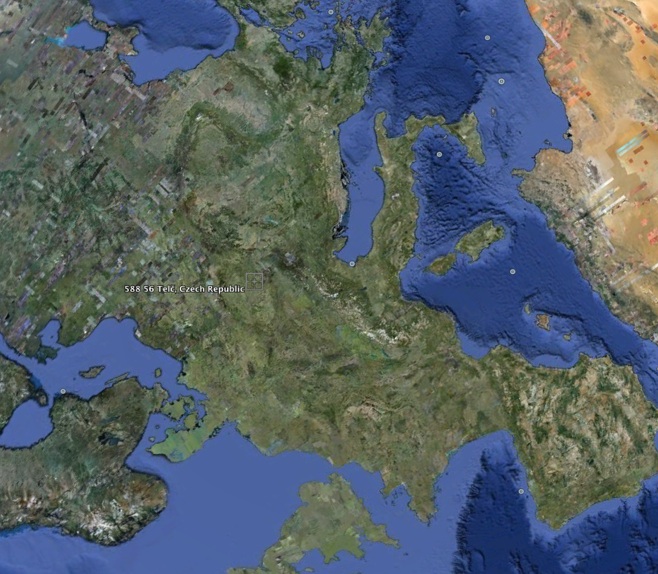
Here is a Google Earth overview to be compared with the Ravenna Cosmography
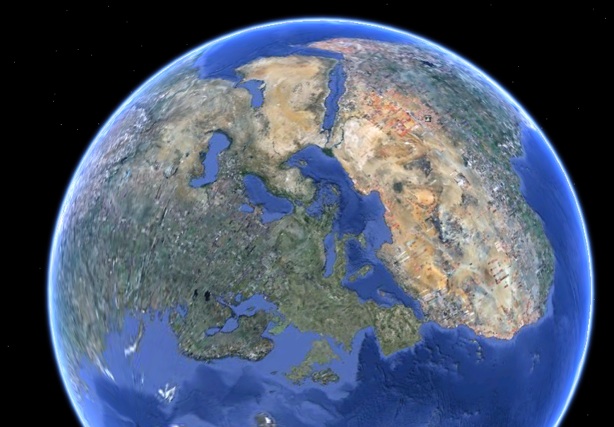
For the Roman world of 700 AD the Ravenna Cosmography map is not too bad.
According to a www.livius.org/cg-cm/claudius_i/claudian_army_reforms.html web page:
"... Both Caligula and Claudius had ... plans to invade Britain ... it seems that Claudius created the limes along the Rhine and Danube ...".
The utility of the Rhine and Danube as fortified border regions of the Roman Empire is shown by this contemporary physical map
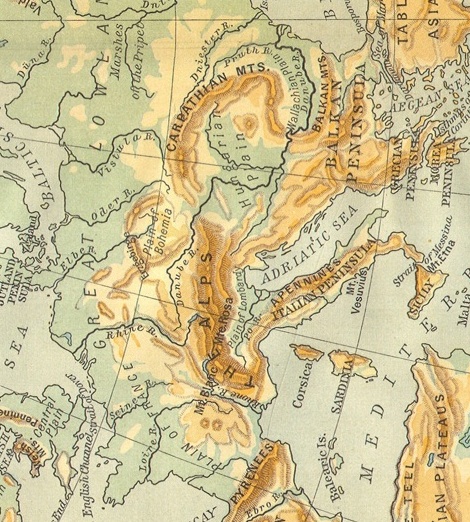
You can see how our Y-DNA ancestors of North Eastern Italian Roman Legions went around the Alps to the Danube, and then up to the Danube headwaters North of the Alps to the headwaters of the Rhine and then down the Rhine to the sea near Britain, and then from there invading Britain.
The same general situation is shown by the 700 AD Ravenna map, on which I have colored the Danube red and the Rhine green
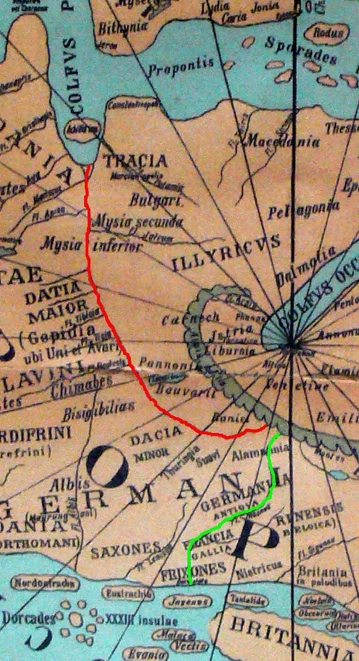
As to the details of the invasion of Britain by Claudius in 43 AD, I have not found anything much better than wikipedia, which says in part:
"... The main invasion force under Aulus Plautius crossed in three divisions. The port of departure is usually taken to have been Boulogne, and the main landing at Rutupiae (Richborough, on the east coast of Kent). Neither of these locations is certain. Dio does not mention the port of departure, and although Suetonius says that the secondary force under Claudius sailed from Boulogne, it does not necessarily follow that the entire invasion force did. Richborough has a large natural harbour which would have been suitable, and archaeology shows Roman military occupation at about the right time. However, Dio says the Romans sailed east to west, and a journey from Boulogne to Richborough is south to north. ... An alternative explanation might be a sailing from the mouth of the Rhine to Richborough, which would be east to west. ...
Strabo (Geography 4:5.2) names the Rhine as a commonly-used point of departure for crossings to Britain in the 1st century AD. ...
Suetonius says that Claudius received the surrender of the Britons without battle or bloodshed. ... Cassius Dio relates that he brought war elephants and heavy armaments which would have overawed any remaining native resistance. ...".
According to a danube-limes.eu web page:
"... in the reign of Claudius (41-54 AD) ... the Romans ... came into power ... and the frontier was put forward to the Danube ... the army was stationed on the Danube limes by the end of the 1st century AD ... The evolved frontier existed nearly 400 years ... The last building campaigns date to the time of the Constantine dynasty (306-350) and the reign of Valentinan (364-375). ... After the death of Valentinan ... In 377 AD a united army of Goths, Alans and Huns invaded Pannonia ...(today Hungary ...)... in 433 AD the province was finally occupied by the Huns of Attila. ...".
According to Britannia.com web pages: "... AD ...
Going back N generations, the purely female and purely male lines are just 2 lines out of 2^N, so a lot of my ancestry ( 2^N - 2 lines at N generations ) is not tracked by those two lines.
For instance, the line of my African slave 5-great-grandfather came to me through my mother, so it is a mixed ancestry ( F - M - F - F - F - F - M ) that is among the 2^(2+5) - 2 = 2^7 - 2 = 128 - 2 = 126 lines that, at 7 generations, is not detected by the purely female and purely male DNA tracking that I did with the Genographic program.
Another mixed ancestry, through my father ( M - F - F - M - F ), goes back to Minerva Steadham (ca 1800s) of Germany. According to an article by Richard L. Steadham in the Spring 2008 issue of The Timen Stiddem Society newsletter: "... As it currently stands, our haplogroup is classified as E3b1a2, which places our family at that spot ... on the Y-chromosome phylogenetic tree ... a possible (though not absolute) description of our ancient ancestors' migrations over the centuries went something like this: Our proto-Stidham* ancestors (as I'll call them) were Thracian or Illyrian tribesmen ...
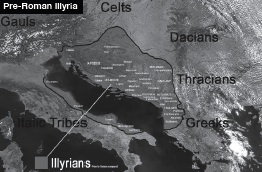
... living somewhere in the Balkans during the centuries before Christ. They were pagan worshipers and fierce warriors and resisted the Roman army's attempts to bring them under their rule for many centuries. In the first century A.D., the Romans succeeded in subjugating them and began employing them as mercenaries in the armies of various rulers during the Hellenic period, and later as Roman auxiliary troops in their legions from the second century onwards ... these Thracian/Illyrian - now Roman - soldiers could have been ... our ancestors and was sent to the Roman province of Britannia and stationed at the Saxon Shore Fort of Portus Adurni (later to become Portchester Castle) ...
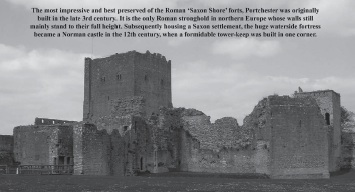
... to defend the Roman-Britains from invading Saxons. Soldiers stationed at these forts eventually took local wives and raised families of their own for many generations before the Romans left Britain early in the 5th century A.D., during the empire's decline and retreat. Portchester Castle is about 20 miles from the village of Stedham ... originally called Steddanham ... From the 3rd or 4th through 16th centuries ... our ancestral line could have lived and flourished in Southern England in the County of Sussex ... At a point prior to the early 1600s (Timen Stiddem's birth in Hammel, Denmark or possibly Germany) the family could have left England. ... the family ... evidently left England for whatever reasons and wound up in the Netherlands, and eventually Gothenburg, Sweden where we learn that Luloff Stidden (Timen's father) was known as the Dutchman ...".
To try to find out about the vast bulk of my ancestry that is not detected by purely male and purely female tracking, I also did some autosomal DNA tracking using DNA Consultants, whose web site says in part:
"... Our ... DNA Fingerprint Test examines all your ancestral lines at once, to tell you which countries and ethnic groups your ancestors came from. The test confirms any Native American, African or Asian ancestry; if you are primarily European, you will also receive your top ten matches from different European countries. ... The DNA Fingerprint Test will analyze your DNA sample against 16 standard STR markers, also called CODIS markers. (CODIS stands for Combined DNA Index System, and it probably sounds familiar if you watch any of television's popular procedural crime shows like CSI.) ... Unlike other autosomal tests, the DNA Fingerprint Test computes the likelihood of its matches on the basis of contemporary populations, not ancient world migrations or evolutionary theory. ...You may add the 18 Marker Ethnic Panel for further confirmation of Native American and other ancestry. ... The 18 Marker Ethnic Panel or DNA Fingerprint Plus goes beyond the DNA Fingerprint Test to examine your CODIS markers and tell you if your profile contains any of the newest ethnic markers. The Plus Panel confirms any Native American, African or Asian ancestry. It also checks for Ashkenazi Jewish, Eastern European, Mediterranean and several other markers identified by our scientists. ... It also tells you if you have a false ethnic marker, for instance, an Asian false positive. False markers are accidental and misleading. ...".
My DNA Consultants report (received 3 December 2009) said: "... Frank D. Smith, Jr. DNA Fingerprint Report Plus 18 Marker Ethnic Panel ...
autosomal markers were analyzed at Genetic Testing Laboratories. ... The table shown below depicts the alleles ... at each locus ...
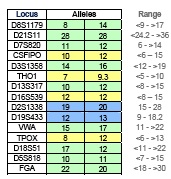
... The scores shown in green and yellow above known as CODIS makers were compared with profile sequences for over 380 populations from around the world stored in a databank known as OnmiPop ... The following populations proved to be the leading matches for the subject on a 15-marker basis (numbers in parentheses are keyed to the original published studies) and according to averages:
Rank World Population Matches RMP 1 Michigan Nat.Am. (2) 1.51E+16 2 Portuguese (6) 2.72E+16 3 Scottish (11) 3.41E+16 4 Caucasian (268) 3.80E+16 5 California Caucasian (2) 4.38E+16 6 PBSO Hispanic (4) 4.51E+16 7 Polish (217) 4.65E+16 8 Belgian (248) 5.55E+16 9 Argentinian (113) 5.92E+16 10 Madeira Archipelago (53) 6.07E+16 11 PBSO Caucasian (4) 6.33E+16 12 South African (European) (262) 6.37E+16 13 Arizona Hispanics (2) 6.55E+16 14 Australian Caucasian (294) 6.97E+16 15 Native American (268) 7.01E+16 16 British (298) 7.33E+16 17 Michigan Hispanics (2) 8.04E+16 18 Polish (176) 8.05E+16 19 RCMP Saskatchewan Aboriginal (56) 8.2E+16 20 NCSBI Caucasian (4) 8.44E+16
A Random Match Probability (RMP) expresses commonness or rarity of the subject's profile in a given population. For a figure such as 2.38+E13, add 13 digits or zeros to the right of the decimal point, making 1 in 23,800,000,000,000 chances for its occurrence. The lower the number the stronger the match. Results are shown on the attached ancestry map, where green indicates locations of strongest probable genetic origins, red likely absence of ancestry, and brown weak or ambiguous contributions of ancestry. Clusters of bright green confirm major prehistoric ancestral homelands. ...
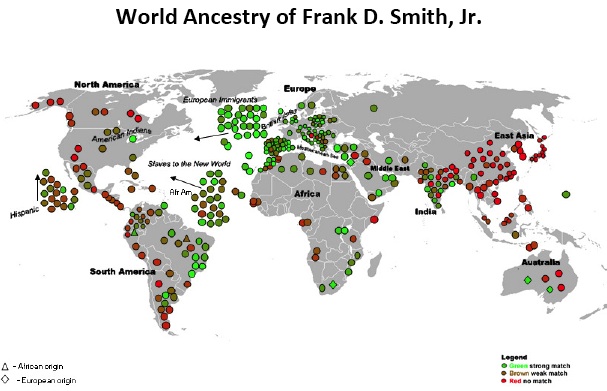
... Profile frequencies and averages suggest the subject's principal ancestries are Danish (I), Italian (II), Austrian (III), German (IV), Croatian (V), Swiss (VI), English/Welsh (VII, 16, cf. Caucasian 4, 5, 11, etc. ), French (VIII, IX) and Lowlands Scottish (X, 3) with American Indian (1, 15, 19, markers) and Sub-Saharan African (map, markers) admixture. There was a match with Hungarian Ashkenazi (map) and Sephardic Jews (green diamond in Israel). ... some of the Iberian matches ... can probably be attributed to deep ancestry, as it is believed that Iberians on the Atlantic Coast such as the Basques and Portuguese were the leading colonizers of the Brtish Isles following the last Ice Age ... There appears to be no Sub-Continental Indian, East Asian or Australoid, any apparent matches being due to accidental convergence ...
... 18 Marker Ethnic Panel ...
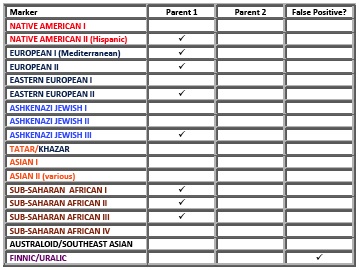
... These eighteen markers have been found by DNA Consultants to correlate with probable ethnic ancestry as indicated. They reflect major human migrations ...you receive one allele ... from one parent and one from the other, you can potentially have two markers, one, or none. It is not possible to say which parent you get a marker from ...
... Full European Database Index: 1.4782E-14
This number reflects the rarity or commonness of your genetic profile in Europe ... The index figure is expressed as a negative exponent ... The lower the index ... the less European you probably are in your overall background ... The range is -12 (common) to -20 (rare) ...".
According to a USGS web page at tapestry.wr.usgs.gov/09michigan.html
"... A giant incomplete bulls-eye is centered on the state of Michigan. ...
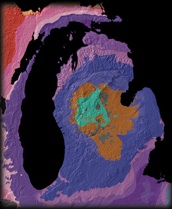
... Extending into Illinois, Ohio, Indiana, Wisconsin, and Ontario, this annular pattern outlines the Michigan Basin, a bowl-shaped structure of uncertain origin that contains over 4 km of inward-dipping Paleozoic strata and a veneer of Jurassic sedimentary rocks. This mysterious basin ... subsided rapidly from Cambrian to Silurian time as it filled with shallow-water marine sediments, some of which host deposits of petroleum, coal, and salt ...".
According to a Michigan State geology web page at www.geo.msu.edu/geo333/MIbasin.html
"... There is a marked contrast between the old, resistant Precambrian and Cambrian rocks of the western half of the Upper Peninsula and the sedimentary rocks of the rest of Michigan. The limestones, sandstones and shales, which dominate the Michigan Basin of the lower peninsula, are approximately 500 million years old, some perhaps less. The sediments that form these sedimentary rocks were deposited on the bottoms of ancient seas, and the rock layers are piled on top of each other like saucers. The edges of the sedimentary rocks appear at or near the surface in northern Michigan-for example, near the Straits of Mackinac. In the center of the basin, they are about 14,000 ft (4,267 m) thick. ...".
According to a web page at www4.vc-net.ne.jp/~klivo/gen/geology.htm by CLEVE (1999)
"... Four hundred and forty-five million years ago, in an era known as the Ordovician to geologists, there was a sea in the Michigan Basin. ...
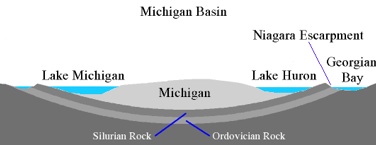
... Two hundred and fifty million years ago, the sea disappeared for the last time. Then a long period of erosion began. ...".
According to an article by Frank William Kinsman at scorpio.tn.cornell.edu/ACM/web_abs.html
"... the partial ring formed by Lakes Michigan and Huron might be the result of an asteroid or comet impact. Some geologists believe that the major topographical elements of the Great Lakes are inherited from preglacial land surface. Today Lakes Michigan and Huron have the same level. They have several marked similarities, including similar depths, breadths, surface areas, and drainage basin areas. Since they have been collecting silt for thousands of years, they must have been very deep at the end of the last glacial period. Also, Lakes Michigan and Huron are remarkably duplicated, in miniature, by the two lakes that exist in the Brent impact crater in the northern edge of Algonquin Park in the Province of Ontario. ... The Finger Lakes are all radial to the deepest point in Lake Ontario. ... the Finger Lakes ...[may have been]... formed when an asteroid or comet formed Lake Ontario, and produced radial cracks in the brittle stone plate beneath Central New York State ...".
According to The Michigan Basin as an Impact Structure by J. B. Hartung in Meteoritics, Vol. 13, p.488
"... The Michigan basin is ... a geologic basin and may represent the site of a large impact event about 2.4 b.y. ago. ...".
According to a Michigan Historical Museum web page at www.hal.state.mi.us/mhc/museum/explore/museums/hismus/prehist/mining/copper.html
"... Native Americans used Michigan copper as early as 5,000 B.C. They found it on Isle Royale and in the Upper Peninsula regions of Michigan that we know as Keweenaw, Houghton and Ontonagon counties ...
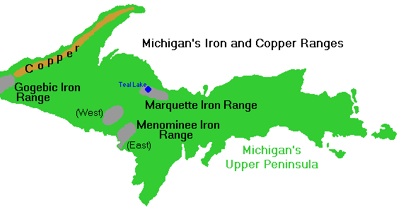
... Using hammerstones, they broke off chunks of the pure soft metal. Sometimes they heated the rock with fire, then cooled it with cold stream or lake water to make it break apart more easily. They hammered copper into tools, implements and ornaments for use or trade. Michigan copper eventually reached as far as southern Florida through their trade networks. ...".
According to a web page at www.exploringthenorth.com/mine/history.html
"... prehistoric excavations located on Adventure Bluff ... of the Copper Country ... date to about 5,000 years before present ... The Mine is located on ancient precrambrian basaltic lava flows and the copper being mined occurred only in pure native metallic form. Large masses of pure copper were routinely encountered in this mine and pieces weighing up to several tons were not at all uncommon. Copper occurs in the top gaseous portions of the lava flows with the copper acting as a filler in cracks and voids of the rock. Post-volcanic activity formed the copper (likely from precipitation out of warm-water solutions permeating throughout the host rock) and it was never molten with the initial basaltic lavas. There are none of the common copper oxides such as azurite or malachite present here. ...".
According to Geology of the Keweenaw Peninsula by Paul T. Brandes at www.mindat.org/article.php/255/Geology+of+the+Keweenaw+Peninsula,+Michigan
"... The Keweenaw Peninsula, located in Michigan's Upper Peninsula, is home to the single largest concentration of native copper deposits in the world. ... Between 1845 and 1996 when the White Pine mine closed and ended copper mining in Michigan, the district produced approximately 15.5 billion pounds of copper. In 150 years of mining in the district, only about 40 percent of the total estimated copper contained in the deposit has been mined out. ... Bornhorst et al. (1988), using Rb-Sr methods, determined the age of mineralization at between 1,060 and 1,047 Ma, some 30 my after rift filling volcanism, but contemporaneous with reverse faulting along the Keweenaw Fault. ... As the lavas were erupted, it is thought that degassing removed large amounts of sulphur from the basalts and thus the ore fluids had a very low sulphur content ... Movement of these fluids was accomplished through the many faults and fractures formed during regional compression and subsequent deformation. Since the age of native copper emplacement is nearly contemporaneous with compression and faulting of the ... Portage Lake Volcanics ... (around 1,060 Ma), this provided the necessary plumbing system to allow ore fluids an easier path to their final deposition place ... Without sulphur in the system, the copper was deposited as native metal instead of copper sulfide. The major compressional event late in the ... Mid-Continent Rift ... system may have provided the difference in the genetic model to generate the world class native copper deposits in the Keweenaw Peninsula and nowhere else ...".
According to The State of Our Knowledge About Ancient Copper Mining in Michigan, The Michigan Archaeologist 41(2-3):119-138 (1995) by Susan R. Martin at www.ramtops.co.uk/copper.html
"... the ... ancient copper industry of the Lake Superior Basin ... The duration of prehistoric mining is ... from about seven thousand years ago ...".
According to Sailing to Paradise - the Discovery of the Americas by 7000 B.C. by Jim Bailey (Simon and Schuster 1994):
"... the earliest pure copper was extracted in economic quantities ...[at]... Lake Superior ... Isle Royale and the Keweenaw Peninsula ... around 6000 B.C. Much of it was in the form of boulders of pure copper. To the Greeks these were the golden apples of the Hesperides, the island in the remote west beyond the Atlantic ... to the Welsh these would be the apples of Avalon. ... Dikodorus ... says, while discussing the tin trade, that there is an island in the open sea directly opposite Scythia - a name for northern Europe - that is called Nisos Basileia, i.e., the royal island ... Compare the Welsh name Avalon for the Island in the middle of the Ocean to the Hebrews name Havilah of Genesis, for the land around which the Pishon flows ...[Genesis says "... Pishon ... winds through the whole land of Havilah, where there is gold. The gold of that land is good ... ", and it seems to me that Pishon refers to the Aras River, through the Caspian Sea, the Volga River to northern Europe and then across the Atlantic to America including Lake Superior.]... The Francthi cave in southern Greece reveals that by 7500 - 7000 B.C. the inhabitants were already involved in deepwater sailing. ... Mining and the fashioning of copper tools and weapons were carried on ... at Lake Superior ... from the sixth millennium B.C. to 1000 B.C. ... This dating ... means that the use of copper began at about the same time in America as around the Black Sea and in the Middle East. ... The stone mauls used for copper extraction around Lake Superior were of a type used for early mining everywhere. ... Despite ... use of ... smelting, sometime in the fifth millennium ...[to open up]... many new sources of copper in the Old World ... for example, extensive copper mines in Sinai ... around 300 B.C. ... the N orth American trade in copper with other parts of the world continued. The mines on Isle Royale did not go out of use until 1000 B.C. just as we cannot account for the supply of native copper (and, later, alluvial tin associated with the copper) in the Old World, so we cannot find evidence in the New World that anything like enough metal was used there at this time to absorb the output of the mines. ...... Greek tradition suggests that in the Copper Age nations were relatively peaceful, differences being settled by agreement or by casting lots. ... Hesiod records that the Bronze Age became increasingly bloodthirsty and warlike, I think perhaps due to the pressure of mounting populations on limited resources - in addition to the temptation presented by the terrible excellence of the weapons ... We must inquire whether the early history of Christianity, which Eusebius ... said preceded the time of Moses, was not developed in the New World as much as the Old. ...
... legends ... may throw some light on the metalworkers of this time. ... Vulcan, the Titan who spent his life laboring at the subeterranean forge ... was a cripple, and this can be attributed to his handling of arsenical bronze. ... the Cyclops, the race of giants having a single eye in the middle of the forehead ... forged Zeus's lightning ... their single eye ...[may have been]... a symbol, a sun circle, stamped on the foreheads of the bronzesmiths to make them permanently recognizable in case they should try to leave the country, taking their all-important trade secrets with them. ...
... It was ... a critical moment when, as early as the middle of the third millennium, sources of tin for the Middle East began to dry up. ... Around 2300 B.C. ... Sargon the Great ... mounted overseas expeditions to secure supplies of tin. Contemporary inscriptions record that he crossed the sea in the west, and in a general review of his empire he is credited with control of two "lands beyond the Upper Sea" (the Mediterranean) ... The Bible gives the source of tin as Tarshish, alias Tartessus, a port on the Atlantic coast of Spain ...[where]... the biggest ships were built ... though there were tin mines in Spain they were worked even later than those in Britain, and ... they were not near Tarshish. Tarshish must have been ... where tin brought from further afield was stored and transshipped ... through the Mediterranean to its final destination. ... Homer said that tin came out of the Atlantic to the Mediterranean and ... there are only two places beyond the Strait of Gibralter that could supply tin in anything like the quantities that they used. One is Africa, the other is the Americas. ... in America ... the main sources of tin were to be bound. ... The Amazon ... placer deposits consist of particles of metal washed down the river from their origin in hills in Bolivia ... The Amazon also provided lijitless supplies of wood that could be turned into charcoal and used for smelting and casting the metals, while the Middle Eastern countries had exhausted their own timber by the same process at a surprisingly early date in the Bronze Age ...
... the Sea Trade Ended, Bringing Isolation and Backwardness to America and West Africa ... the trade with Africa and America fell away after the end of the Bronze Age ... in the Iron Age ...
... Once the bronze trade had collapsed the seat of the gods was transferred from the Andes to two mountains in Greece. ... Olympus was simply a corruption of Atlantis ...".
It seems to me that about 11,000 to 6,000 years ago may have been the period through the Copper Age about which Diodorus of Sicily said:
"Now the Ethiopians ... were the first of all men. ... the Egyptians are colonists sent out by the Ethiopians, Osiris having been the leader of the colony ... Osiris ... gathered together a great army, with the intention of visiting all the inhabited earth and teaching the race of men how to cultivate ... for he supposed that if he made men give up their savagery and adopt a gentle manner of life he would receive immortal honors. ...", and that Osiris then went from Egypt and Ethiopia to Arabia, Greece, and India.
The Vedic view (see nersp.nerdc.ufl.edu/~ghi/vcchap.html) of what happened next, into the Bronze and Iron Ages and on through the present Industrial Age, is that
"...prior to the beginning of Kali-yuga about 5,000 years ago ... all living beings were on a higher average level than they are at present, and advanced beings such as demigods and great sages regularly visited the earth. ... Once the Kali-yuga began, demigods and higher beings greatly curtailed communications with people on the earth, and the general sensory level of human beings also declined. ... due to the lack of feedback from higher sources and the natural cheating propensity of human beings, the traditions ... became more and more garbled ... the present stage of civilization was reached, in which old traditions are widely viewed as useless mythology, and people seek knowledge entirely through the use of their current, limited senses.".
It also seems to me that my strong Autosomal DNA match to Michigan Native Americans (but only at most weak matches to other North American Native Americans) could be accounted for by:
my strong matches in Mediterranean populations that were early seafarers; andgenetic mixing of Mediterranean early seafaring populations with Michigan Native Americans during Copper Age and Bronze Age trans-Atlantic trading of Lake Superior Copper.
...
Frank Dodd (Tony) Smith, Jr. - 2009
Here is an outline of some relevant circumstances:
1 - My mother's baby was entangled with the umbilical cord and positioned for a head-last birth on 13 March 1941 (prior to routice Caesareans, antibiotics, etc).
2 - My mother elected to have a general anesthetic, as she wanted to be unaware of the birth.
3 - Dr. Sam Howell told my father that he could be sure to protect the health of my mother by cutting up the baby and removing it, or he could try to manually extricate the baby with consequent increased risk to my mother's health.
4 - My father (not my mother's input) decided that Dr. Sam Howell should try to manually extricate the baby (a decision that my mother resented when she later found out about it).
5 - As a consequence of manual extrication, my mother became extremely ill and was treated with sulfa drugs, and was unaware of what was going on during and after the birth for many days, and had no contact with the baby during that time.
6 - A few days later in March 1941 Marguerite Pierce gave birth to John Pierce,and John and I were both nursed by Marguerite Pierce.
7 - A few months later, my mother took me on a stroller to town and met a local lawyer, Claude Pittman, who told my mother "I thought your baby died",which made my mother intensely dislike Claude Pittman.(my mother told me that story repeatedly as I was growing up.)
8 - If Claude Pittman had been correct and the baby had died, although my father had a World War II occupational deferment (mining iron and manganese, which were needed to feed the Alabama steel mills), the early years of WWII (like 1941 when I was born (whether adopted or not) were uncertain, and having a child would help him keep the deferment.
9 - If the baby had died, my father could have contacted his brother Taxi to get a replacement baby boy, since Taxi as a lawyer doing criminal defense work had Mafia ties (my parent's wedding rings were bought from a mysterious man that Taxi brought to a hotel room in the Henry Grady Hotel, and I remember a shotgun given to him by the Mafia) and the Mafia (through connections to prostitution and Catholic adoption homes) could easily have supplied a replacement baby boy for which my father (through his mining business) could have afforded to pay.
10 - My father objected to my mother's suggestion that I be named Frank Dodd Smith, Jr. My mother prevailed as to the official name, but my father insisted that I be called something else. My mother asked what else, and my father said "Tony", despite the fact that "Tony" was not a name of anyone in their family trees. However, "Tony" is a common Italian name (for example, the Italian boxer Two-Ton Tony Galento) and my father may have wanted to pay homage to my source. Despite my repeated questioning, my father never told me why he chose the name "Tony".
11 - The time to get a replacement from New York to Cartersville would have been consistent with the few-days difference between my mother's delivery date and the birth of Marguerite Pierce's son John Pierce.
12 - During the few-day period my mother was so sick that she would not have known what was going on, and she did not come into contact with me (being too sick) until after I had been nursed by Marguerite Pierce.
13 - My father, my uncle Taxi, and Dr. Sam Howell would have had no problem with deceiving my mother and the general public.
14 - Some workers in the hospital could have figured out the truth, which would have gone into the Cartersville Gossip Circuit as a rumor that Claude Pittman could have picked up.
15 - My recent DNA tests indicate substantial Mediterranean ancestry (my paternal Y-choromosome line went from Africa to the Italy-Greece-Balkan area, and autosomal tests indicate strong matches to Mediterranean populations), all of which would be consistent with Mafia adoption.
...
Frank Dodd (Tony) Smith, Jr. - 2009
Although I have no brothers or sisters, my cousin Fred Smith and I have the same paternal grandfather, so our Y-chromosome ancestral history should be the same for the time period before our common paternal grandfather. According to National Geographic Genographic DNA results:
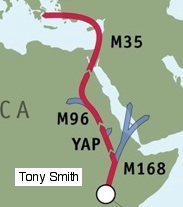
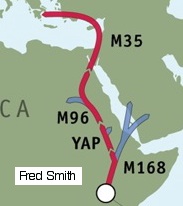
so our DNA results are consistent with me being born of my mother, and not adopted.
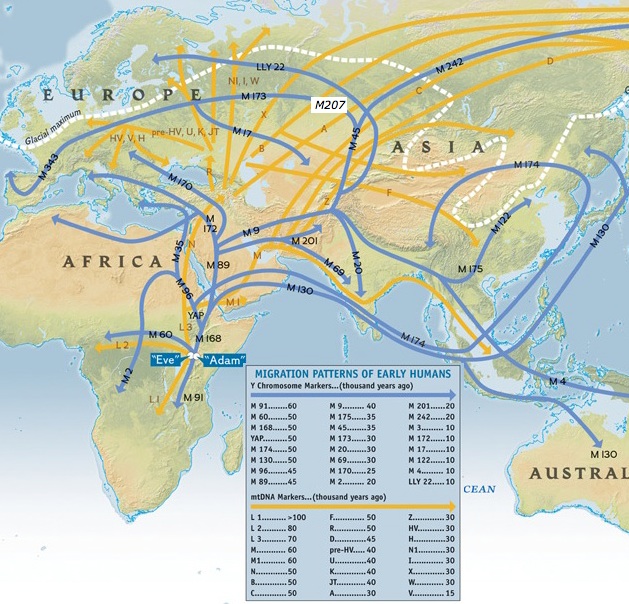
Around 40,000 years ago
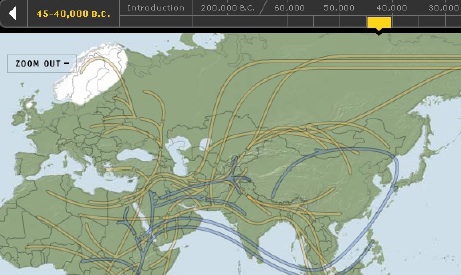
Around 35,000 years ago
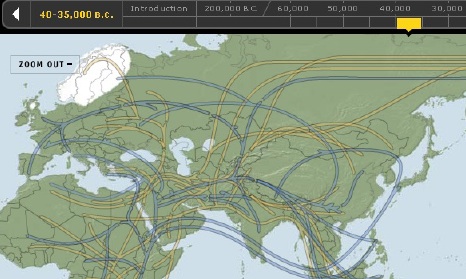
Further, other branches of M89 (that is, M172 and M170) went into the Mediterranean and Southern Europe.

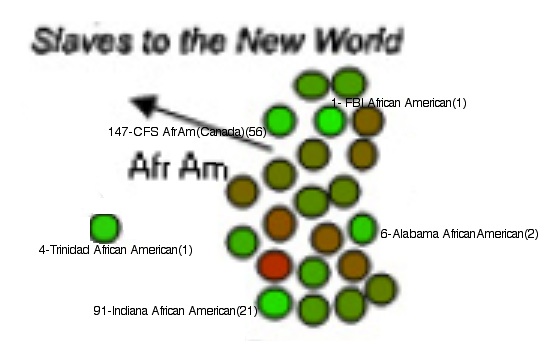
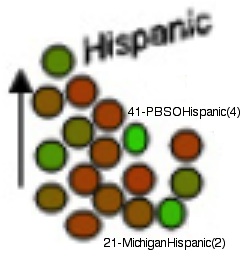
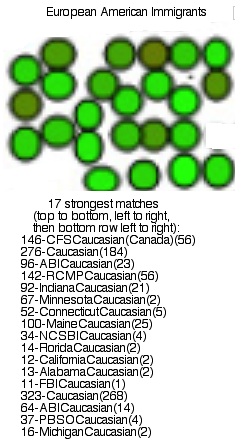
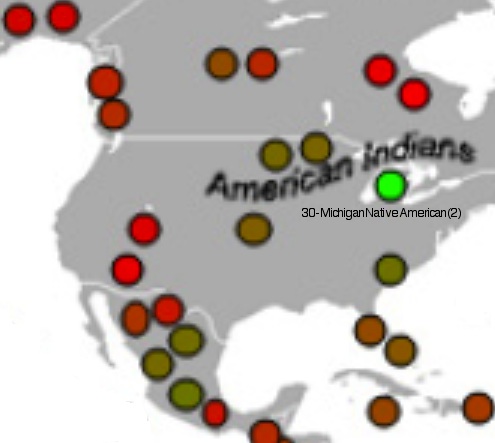
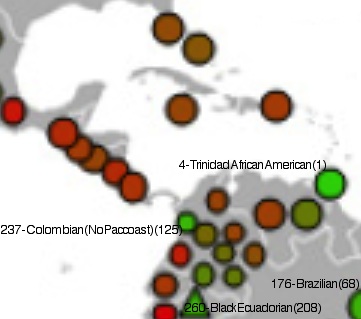
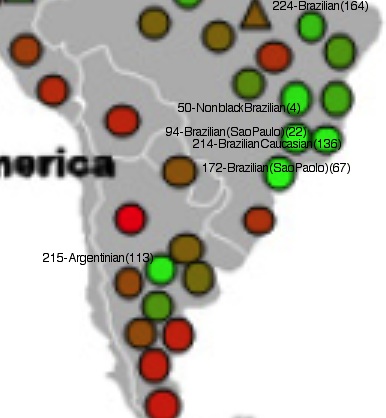
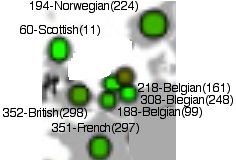
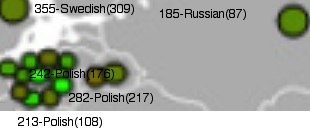
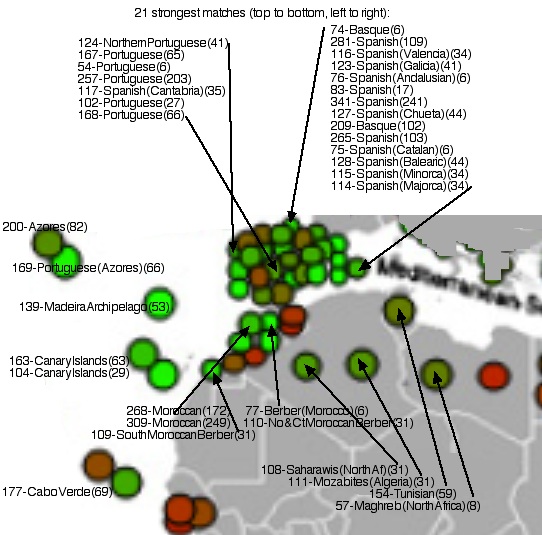
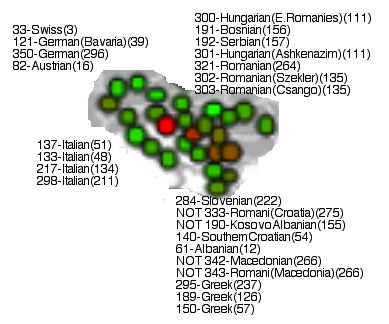
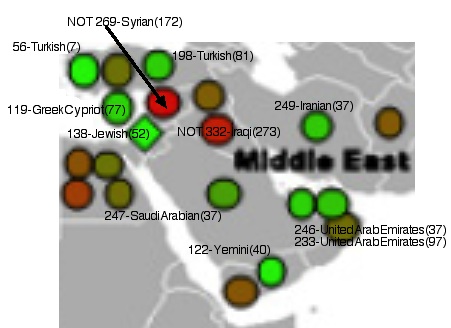
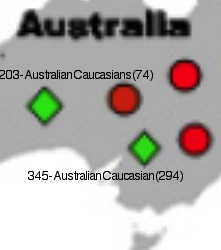
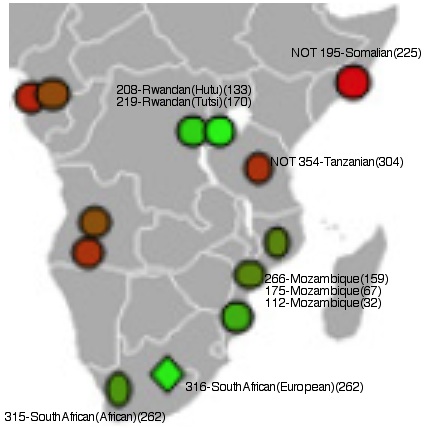
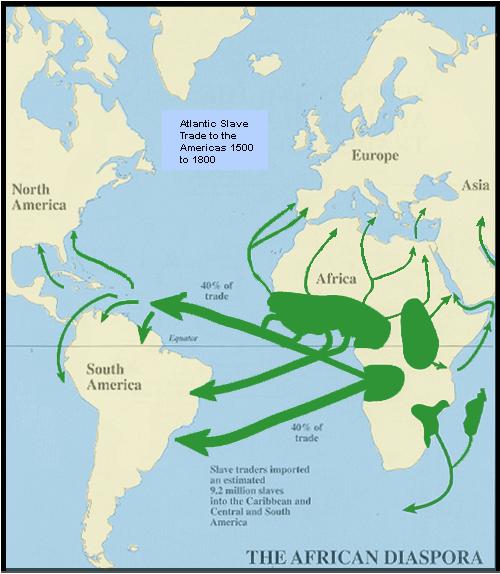
With respect to African-American slave trade, my African genetic matches seem to correspond to slave trade from Mozambique as shown in the above map from the MacMillan Encyclopedia of World Slavery: Volume 11 (Paul Finkelman and Joseph C. Miller eds, Simon and Schuster, New York, 1998) described on a wysinger.homestead.com web page.
According to a wikipedia article on Atlantic slave trade: "... Most historians now agree that at least 12 million slaves left ...[Africa]... between the fifteenth and nineteenth century, but 10 to 20% died on board ships. Thus a figure of 11 million enslaved people transported to the Americas is the nearest demonstrable figure historians can produce ... There were eight principal areas used by Europeans to buy and ship slaves to the Western Hemisphere. ... Between 1650 and 1900, 10.24 million enslaved Africans arrived in the Americas from the following regions in the following proportions ... Southeastern Africa (Mozambique and Madagascar): 4.7% ... Over 45 distinct ethnic groups were taken to the Americas during the trade. Of the 45, the ten most prominent according to slave documentation of the era ...[included]... 10. The Makua of Mozambique ...".
According to "Exchanging Our Country Marks" by Michael A. Gomez: "... British colonies imported "large numbers" from southeastern Africa and Madagascar, particularly between 1675 and 1690 ... the colonies of Massachusetts, New York, and Virginia were all receiving "East African" slaves ...".
According to "Slavery and African Ethnicities in the Americas" by Gwendolyn Midio Hall: : "... Mozambique was by far the major region in Southeast Africa from which enslaved Africans were imported. Its slave trade began with relatively small numbers and the escalated and lasted very late. During ... 1641-48 ... the Portuguese focused on slaves from Mozambique. ... During the last half of the eighteenth century ... French slave traders brought some of them to the Caribbean, overwhelmingly to St. Domingue (Haiti) during the last quarter of the eighteenth century. ... some of the slaves from Mozambique were transshipped to from St. Domingue to Louisiana and probably to other colonies as well. After St. Domingue's slaves revolted in 1791, the slave trade from Mozambique became largely a Brazilian/Portuguese operation. After 1808, when the British outlawed the transatlantic slave trade north of the equator, Mozambique becam an important source of Africans brought mainly to Rio de Janeiro, Brazil. ... French and British slave traders were very active in Mozambique between the 1850s and 1870s, collecting "contract workers" to ship to the Caribbean, but they were "produced" exactly in the way slaves were. ... After 1854, demand for "contract laborers" ... led to extensive slave raiding among the Makua. Its effect was devastating. ...".
Frank Dodd (Tony) Smith, Jr. 2010